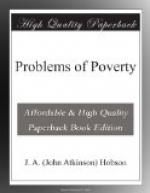Turning from pauper deaths to pauper lives, the condition of the poor, though improved, is far from satisfactory. The agricultural labourer in many parts of England still looks to the poorhouse as a natural and necessary asylum for old age. Even the diminution effected in outdoor relief is not evidence of a corresponding decrease in the pressure of want. The diminution is chiefly due to increased strictness in the application of the Poor Law, a policy which in a few cases such as Whitechapel, Stepney, St. George-in-the-East, has succeeded in the practical extermination of the outdoor pauper. This is doubtless a wise policy, but it supplies no evidence of decrease in poverty. It would be possible by increased strictness of conditions to annihilate outdoor pauperism throughout the country at a single blow, and to reduce the number of indoor paupers by making workhouse life unendurable. But such a course would obviously furnish no satisfactory evidence of the decline of poverty, or even of destitution. Moreover, in regarding the decline of pauperism, we must not forget to take into account the enormous recent growth of charitable institutions and funds which now perform more effectually and more humanely much of the relief work which formerly devolved upon the Poor Law. The income of charitable London institutions engaged in promoting the physical well-being of the people amounted in 1902-3 to about four and a half millions. The relief afforded by Friendly Societies and Trade Unions to sick and out-of-work members, furnishes a more satisfactory evidence of the growth of providence and independence among all but the lowest classes of workers.
The improvement exhibited in figures of pauperism is entirely confined to outdoor relief. The number of workers who, by reason of old age or other infirmity, are compelled to take refuge in the poorhouses, bears a larger proportion to the total population than it did a generation ago. In 1876-7 the mean number of indoor paupers for England and Wales was 130,337, or 5.4 per 1000 of the population; in 1902-3 the number had risen to 203,604, or 6.2 per 1000 of the population. This rise of indoor pauperism has indeed been coincident with a larger decline of outdoor pauperism through this same period. But the growth of thrift in the working-classes, the increase of the machinery of charity, the rise of the average of wages—these causes have been wholly inoperative to check the growth of indoor pauperism. Nor, if one may trust so competent an authority as Mr Fowle, is this explained by any tendency of increased strictness in the administration of outdoor relief, to drive would-be recipients of outdoor relief into the workhouse.




